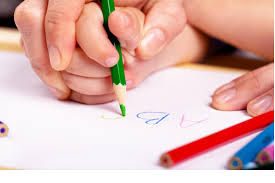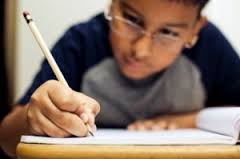 Learning to write is a big challenge when you are a child. It takes concentration, persistence and skill to be able to master it. Some children however, find it extra difficult and they often have to make some unusual compensations to allow them to write properly.
Learning to write is a big challenge when you are a child. It takes concentration, persistence and skill to be able to master it. Some children however, find it extra difficult and they often have to make some unusual compensations to allow them to write properly.
These compensations can include;
- gripping the pen very tightly
- having an unusual pencil grip
- Sitting in an awkward position while writing
- turning the paper 90 degrees on the table
- refusing to learn ‘joined-up’ writing
Why is handwriting harder for some children?
Children that have difficulties handwriting often have Retained Primitive Reflexes. Specifically the ATNR (Asymmetrical Tonic Neck Reflex) has a profound affect on the child’s ability to write with ease. To understand how this reflex affects handwriting it is important to first understand its function.
Primitive reflexes are automatic physical movements which help new born babies survive their early lives. For example, the Moro reflex makes a new born take its first breath. The reflexes should be fully integrated in the first few months of life. This happens as the baby develops new ways of moving and no longer has to rely on the reflexes to do a job. The Asymmetrical Tonic Neck Reflex should be integrated between 6 – 7 months after birth.
Handwriting problems and the ATNR
 When a young baby turns its head to the side, you will see that the arm and leg on that side naturally extend. This is the affect that the ATNR has on the body. It is there to help the baby move down the birth canal, in unison with mom’s contractions. It also helps the baby to move its head to the side, if placed on its tummy, thus preventing it from smothering.
When a young baby turns its head to the side, you will see that the arm and leg on that side naturally extend. This is the affect that the ATNR has on the body. It is there to help the baby move down the birth canal, in unison with mom’s contractions. It also helps the baby to move its head to the side, if placed on its tummy, thus preventing it from smothering.
Very often children with a retained ATNR find crawling difficult or skip it completely.
If it is retained in a child they will struggle to learn to write. Why?- because every time they turn their head to the side, their hand on that side wants to open out and the arm wants to extend.
The child is having to work against this automatic response, while writing. Hence the compensations listed above.
Further to this, they will also tend to watch the pen move across the page instead of watching the words, so they don’t always take in what they have written.
The ATNR will also affect the child’s hand eye coordination and can make them clumsy, since the body wants to turn as the head turns. ATNR is very commonly found in association with Dyspraxia.
How can Cork Kinesiology help with handwriting problems?
 I am trained in The Child Centre Method – learning and behaviour program. This method is focused on diagnosing learning and behaviour problems in children, using standard assessments from Educational Psychology. Holistic therapies such as sound therapy and kinesiology can then be used as part of a broader treatment program to help the child to resolve any stresses on learning and behaviour.
I am trained in The Child Centre Method – learning and behaviour program. This method is focused on diagnosing learning and behaviour problems in children, using standard assessments from Educational Psychology. Holistic therapies such as sound therapy and kinesiology can then be used as part of a broader treatment program to help the child to resolve any stresses on learning and behaviour.
It is important to understand that the child who struggles to write easily is experiencing physical stress while writing. In my experience there is no better way to access and resolve this type of ‘subconscious’ stress than kinesiology.
The process is gentle and non-invasive and has a profound impact on the child.

